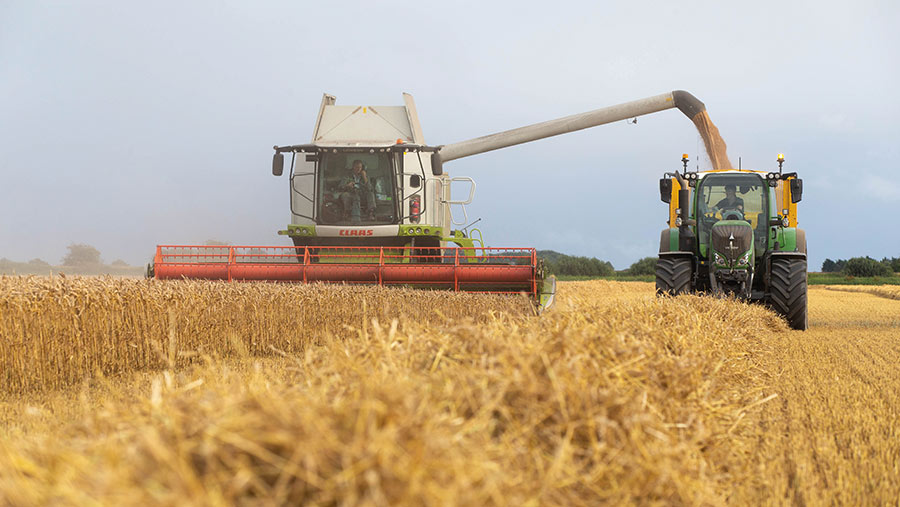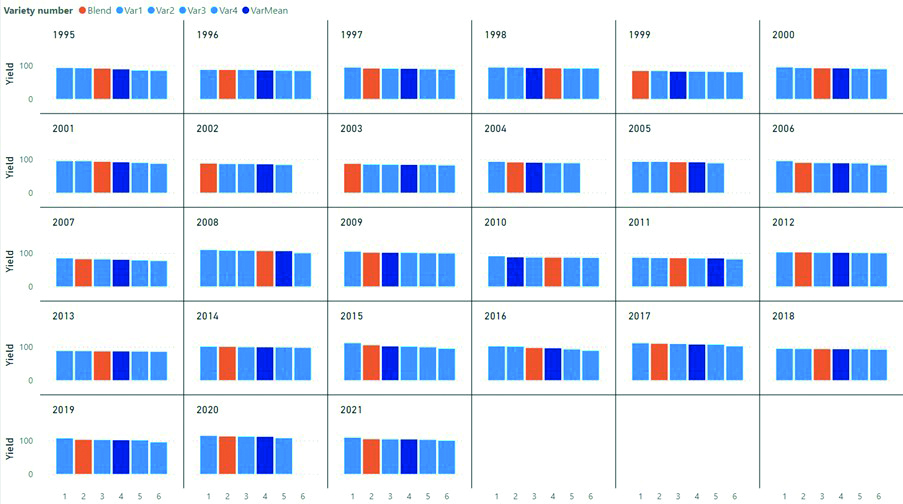Why consistency is a wheat blend’s biggest selling point
 © Tim Scrivener
© Tim Scrivener How much do you value consistency of performance in your crops? If you do, then growing variety blends should perhaps be on your radar.
Long-term evidence from Denmark (see panel), as well as more recent trials in the UK, indicate blends provide a consistent performance with a high floor.
Feed wheats are the easiest place to start with a blend – milling wheat is more complex and end-user acceptance may not be straightforward – with hard feeds currently giving the best combination of parental diversity and disease resistance.
See also: Wheat growers try variety blends to cut costs in the West
After several years of trialling blends, Velcourt, for example, is planning to scale up their use across its farms this autumn, targeting one or two fields on each farm for a total area of around 400ha or 2.5% of its winter wheat area, according to Nick Anderson, Velcourt’s head of crop production technology.
“Blends have reasonably consistently shown a 2-3% yield benefit, whatever level of fungicide applied, over the mean of the component parts in our trials.”
While one of the component varieties, last year for example Extase, often yields higher than the blend, he says that shifts in the field are difficult to predict.
“Blends have the potential to increase the longevity of genetic resistance and also reduce the pressure on fungicides.”
One blend
The business is planning to use just one blend across its farms to simplify seed purchase, technical advice, sales and help maximise feedback from its farm managers, adds Charlie Batten, Velcourt regional farm manager for the South East.
“If each one of our 30 arable farm managers grew a different blend, trying to advise and manage crop inputs on each one would be impossible.”
Using high-potential untreated yields and significant genetic diversity as key criteria, Velcourt’s blend will be made up of Extase, Mayflower, Graham and Champion.
Fungicide inputs will be optimised, although one of the primary reasons for growing is to be less reliant on fungicides.
“I don’t necessarily see blends as a way of shaving out cost. Integrated management is at its core, and if that allows us to cut inputs, great, but equally if we get better disease control from the same level of inputs it will put less pressure on the chemistry and variety,” Mr Anderson says.
Hutchinson’s head of agroecology Ed Brown is finding growing blends is giving his growers extra confidence to significantly reduce fungicide inputs. His primary blend last year was made up of Crusoe, Extase, Gleam and Costello.
“My approach is purely based on genetic diversity, and then home-save until we have a reason not to. I’m hoping we get a little more longevity out of a blend compared with a single variety.
“There’s no doubt there is increased disease resistance from the blend. I’ve seen the individual elements of the blend, for example Gleam or Extase, when grown as a straight have yellow rust, but not in the blend.”
Less fungicide

Oliver Scott © Bradford Estates
Bradford Estates farm manager Oliver Scott is growing that blend for the first time this season, which has allowed him to cut fungicide use by £20/ha. It was drilled behind potatoes in the first week of October.
“It’s looking really well and has kept cleaner through the season,” says Mr Scott. Final success will be judged on yield versus other feed wheats in neighbouring fields, as well as spend and cost of production.
Mr Brown is also advising growers to try a second feed wheat option of Skyscraper, Theodore, Dawsum and Graham, which brings four high-yielding varieties together.
Skyscraper is a little more susceptible to septoria, he admits. “But as part of a blend it won’t be an issue and, if anything, it’s a positive from a resistance point of view.”
With a primary aim of reducing fungicide inputs, he’s not concerned if leaf layer emergence does differ, although his experience with Crusoe and Extase was that there wasn’t enough to make a practical difference.
For this autumn he’s also put together a quality wheat blend containing Crusoe, Illustrious, Extase and Siskin.
His view is if the blend makes specification it can be used for milling, particularly as in mills different varieties are often blended together. “Unfortunately, it is likely the industry will trip itself up over this.”
Milling blend

© Tom Clarke © Tom Clarke
Cambridgeshire grower Tom Clarke has been trialling 2-4ha of milling wheat blends for the past two seasons to see whether they would make milling specification, as well as providing increased disease resistance and resilience.
The answer last year was emphatically yes – with all four achieving milling spec, with one reaching 14.75% protein, he says.
That’s encouraged him to do a nitrogen trial on his black fen soils, comparing his farm standard, which this season is 65% of his usual nitrogen rate, with 50% and 30% plots.
Ultimately, continuing with blends on the farm commercially will require him to find a buyer willing to take them, he notes.
“If this is the way to go agronomically, I need to have some conversations with local suppliers and bigger buyers to see if they will take it.”
Tom Clarke’s milling wheat blends
- Hereward, Zyatt, Mulika, Skyfall
- Hereward, Crusoe, Illustrious, Trinity
- Extase, Siskin, Cochise
- Mulika, Montana, MV Fredericia
AHDB tool helps growers find wheat blends
AHDB has built a tool that allows growers to select and compare three or four variety wheat blends from Recommended List varieties.
Potential options can be filtered by criteria such as end use, maturity and tailored to include or exclude specific varieties.
Two metrics are used to compare blends – weighted agronomic data from the Recommended List, including disease resistance, quality characteristics and untreated yield, and a parental diversity score comparing ancestry of each variety in the blend going back to up to four generations.
“It’s very useful,” Velcourt’s Nick Anderson suggests. “In particular, it allows you to understand the level of genetic diversity in a blend, which is important for when we are designing a blend to take out into the field.”
The tool quickly highlights that finding a diverse parental variety blend is much easier with hard wheats than soft, with plenty of options scoring at or close to the maximum diversity score of 1.0, whereas with soft wheat the maximum score is 0.95 indicating a number of shared ancestors.
Suggested blends’ AHDB metric scores |
||
|
Blend |
Recommended List data score |
Parental diversity score |
|
Extase, Mayflower, Graham, Champion |
83.9 |
1.00 |
|
Crusoe, Extase, Gleam, Costello |
79.6 |
0.94 |
|
Skyscraper, Theodore, Graham, Dawsum |
81.1 |
0.95 |
|
Crusoe, Extase, Siskin, Illustrious |
80.1 |
0.94 |
| Note: Recommended List data score is a weighted score for all characteristics included in the tool: brown rust, yellow rust, septoria, lodging, Hagberg Falling Number, specific weight, untreated yield and protein content | ||
Niab advice for selecting a blend
- Mixtures of three or more varieties show greatest potential for yield stability and disease reduction
- Aim for broad genetic diversity
- Consider maturity date, heights, specific weight and straw strength
- Look for high untreated yield, complementary pest resistance, and good all-round disease resistance
- If home-saving, be aware the variety ratio may change from previous year
- End-user acceptance low for non-feed wheat, so aim to have contract in place pre-drilling
- Check with British Society of Plant Breeders for royalty payments
Danish consistency

The Danish equivalent of AHDB’s Recommended List has been growing a three- or more often a four-way blend of each year’s best-selling certified seed varieties since 1995.
In 25 of 27 years, when compared with the component varieties, the blend has yielded more than the average of the individual varieties, and in 24 of 27 years finished as one of the top three of the usually six comparisons.
It may not be the best-yielding variety each year – just three times has the blend won that competition, but the consistency will likely be an appealing characteristic for many growers.

